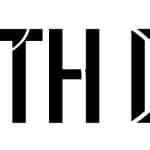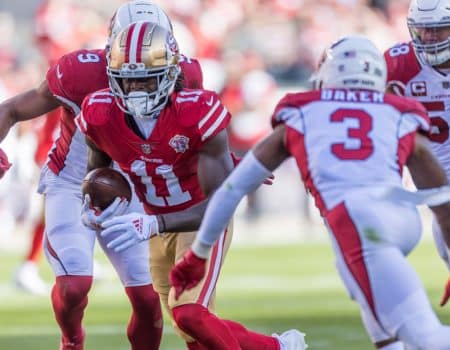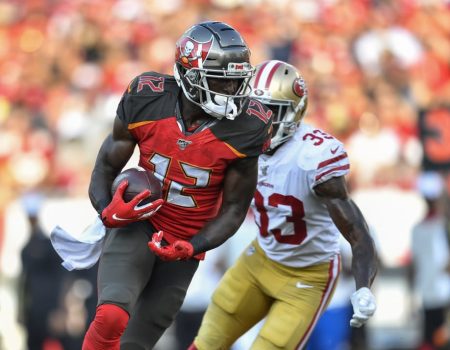The next installment of @PhilPattonNFL ‘s early 2019 fantasy football draft board. The players are ranked based on standard scoring formats. You can see his top 20 here and 21-40 here.
There are several talented players in this tier whose circumstances are less than ideal. A few are coming off major surgeries, while others are surrounded by questions like:
- How high-scoring is their offense?
- Will they fit their new coach’s scheme?
- How much volume will they command?
- How do they fit their offense’s identity?
You should be comfortable answering these questions for every player you draft, as each can single-handedly derail their season. In 2018, Jordan Howard didn’t fit the new Bears offense, Kenyan Drake didn’t get the touches he deserved, the Lions passing offense took a backseat to the running game, and several players fell victim to ineffective offenses with bad QB play. Look out for these red flags in order to avoid the biggest busts in the draft.
41. Devonta Freeman, RB20
2018 was a lost season for Devonta Freeman, who was forced to miss all but two games with knee and groin injuries. He was reportedly healthy enough to play in Week 16, but a return made little sense with the Falcons already eliminated from playoff contention. Next season, Freeman will be operating in an offense that has typically been unfriendly to RBs—Dirk Koetter has had one 1,000-yard rusher (Doug Martin, 2015) in his 7 seasons running the Falcons and Bucs offenses. Freeman has the talent to produce as a top-flight RB, but uncertainty about his durability and his role on offense make him an RB2 in 2019.
42. Derrius Guice, RB21
Derrius Guice looked primed for a breakout rookie year in 2018 before tearing his ACL in his first preseason game. Since then, he’s undergone three procedures to clean up an infection in his surgically-repaired knee. His health will need to be monitored in the offseason, but Guice is a talented player who should be the focal point of the Redskins offense in 2019. If a 33-year old RB can produce as the RB17 behind a banged-up Washington line, so can Guice. Whether the Redskins choose to retain Adrian Peterson will speak volumes about their confidence in Guice’s health and his role in the offense next season.
43. Kenny Golladay, WR17
Kenny Golladay was one of the few bright spots on a Detroit offense that clearly suffered an identity crisis in 2018. Without Golden Tate and Marvin Jones for half the season, Stafford had his fewest yards and attempts in a full season in his career. Matt Patricia showed a slavish devotion to the run game despite poor blocking and an injury to their only starting-caliber back, Kerryon Johnson. The Lions had the fewest rushing attempts in the league from 2015-17, but they were 19th in run% last season while the rest of the league became more pass-heavy. On the bright side, atrocious coaching can only go on for so long before changes are made. Matt Stafford is due for a bounce-back season in terms of TD passes and at 6’4”, Kenny Golladay stands to be the biggest beneficiary. With some more volume in the passing game and another slot receiver/tight end to open up space on the outside, Golladay can be a dominant downfield threat next season.
44. Kerryon Johnson, RB22
The Lions coaching staff served to both the benefit and detriment of Kerryon Johnson in 2018. Matt Patricia implemented a more run-heavy approach but limited Johnson for much of the season in favor of the ineffective LeGarrette Blount. Patricia may have been hesitant to give Kerryon a heavy workload because he’s only received more than 200 touches once since high school. Nonetheless, Johnson is Detroit’s clear-cut lead back heading into next season, and he should be in line for more red-zone touches with Blount now out of the picture. He’s an extremely efficient back who can excel both between the tackles and as a receiver, if given the chance.

45. Robert Woods, WR18
This past season was by far Robert Woods’ best year as a pro. He broke the 1,000-yard mark for the first time and played all 16 games for only the second time in his career. Woods’ role as the possession receiver gives him reliable fantasy production, but his 2018 numbers were somewhat inflated by the loss of Cooper Kupp. Very few offenses can support three fantasy WRs for an entire season and Woods and Kupp operate in the same area of the field—the short-to-intermediate routes. With Kupp returning in 2019 and Cooks signed to a massive contract through 2023, Robert Woods is locked-in as a WR2 with little upside.
46. Phillip Lindsay, RB23
Phillip Lindsay had an unprecedented season in 2018, becoming the first undrafted rookie to make the Pro Bowl on offense. He came out of nowhere to steal the job from 2nd-round pick Royce Freeman in Week 1 and finish the season as the RB10. Lindsay doesn’t have the frame of a prototypical workhorse back, but he was incredibly efficient last year, averaging 6.1 YPC before Emmanuel Sanders’ injury broke the Denver offense. Freeman’s presence in the backfield and the transition to Mike Munchak’s system raise some questions about Lindsay’s value going forward, but he should remain an RB2 next season.
47. Cooper Kupp, WR19
Kupp was one of the most efficient players in the NFL last year. He ranked 4th in the league in average separation and 2nd in YAC/reception among receivers, according to NFL Next Gen Stats. When all three Rams receivers were healthy, Kupp was impossible to guard in the short passing game. He averaged 15 fantasy points/game in games he finished, which prorated over the entire season would have made him the WR2 overall. Of course, there’s a reason he’s not being drafted in the first round this year. He suffered a torn ACL in Week 10, so his health will need to be monitored in the offseason. If Kupp shows the same burst he had in 2018, he’ll be a high-end WR2 going forward.
48. Allen Robinson, WR20
Allen Robinson was a victim of circumstance in 2018; the Bears leaned on their defense and took a more conservative offensive approach, running the ball on 45% of their plays (6th-most in the league). With the departure of Vic Fangio and a regression towards the mean in takeaways, the Bears defense will inevitably take a step back in 2019. That provides an opportunity for Allen Robinson to show his talent, as he did in the Bears’ playoff game with 10 catches for 143 yards and a TD. It took just about all season to feel comfortable in his new offense, but Robinson’s play down the stretch bodes well for his usage next season. Consider A-Rob a matchup-dependent WR2 in 2019.
49. Mark Ingram, RB24
It remains to be seen where Ingram will be playing football next season, but my money is on him returning to New Orleans for their 2019 redemption tour. The Saints have had a top-10 scoring offense every season in Ingram’s 8 years as a pro and they averaged 31.5 points/game last season. His ceiling is capped by the presence of Alvin Kamara, but the high-flying Saints offense guarantees him production in the red zone — Ingram has 6+ TDs in 5 consecutive seasons. Assuming he stays in New Orleans, Ingram projects as a matchup-dependent RB2 in 2019.
50. Andrew Luck, QB3
2018 was a renaissance year for Andrew Luck, who had his best season since he was last fully healthy in 2014. The Colts finally invested in their offensive line and it paid dividends for their entire offense, which finished 5th in the league in scoring. The improvement up front bodes well for Luck’s health going forward and they have oodles of cap space to get him another receiver opposite T.Y. Hilton. The offensive scheme and talent around Luck have finally found some stability, so he should take another step forward in 2019 after his first healthy season in 4 years.
51. D.J. Moore, WR21
D.J. Moore was quietly one of the most efficient players in the NFL last season. He led all WRs in YAC/reception (7.9) and outperformed his expected YAC/R by a whopping 3 yards. To put that into perspective, JuJu Smith-Schuster led the league with 1.9 yards > xYAC/R in 2017. Moore was also limited by Cam Newton’s shoulder injury in 2018 — Cam finished 29th in the league in Avg. Intended Air Yards, ahead of only Blake Bortles, Derek Carr and Mathew Stafford. With a healthy Cam pushing the ball downfield, Moore could be primed for a breakout year in 2019.

52. Alshon Jeffery, WR22
Alshon Jeffery teetered between being a downfield threat and a possession receiver for Philly last season. The Eagles offense took a major step back with injuries to Carson Wentz and surprising ineffectiveness on third down. With an added element of speed on the outside, we could see a bounce-back season for one of the league’s best offenses in 2017. Jeffery commands at least 7 targets/game at this point in his career, so any improvement on offense only stands to benefit his TD numbers. Look for Jeffery to be a low-end WR2 in 2019.
53. Doug Baldwin, WR23
Doug Baldwin’s value may have taken the biggest hit of any player in 2018. He battled several injuries throughout the season and admitted he rarely felt 100%. Baldwin was also limited by an offense that prided itself on its running game—Seattle ran the ball on a staggering 52.4% of its offensive plays, nearly 12% more than the previous season and most in the league by far. Expect the Seahawks to dial up more passing plays against better opponents in 2019, and for a healthy Baldwin to be a matchup-dependent WR2 next season.
54. O.J. Howard, TE4
O.J. Howard was in the midst of a breakout sophomore season in 2018 before foot and ankle injuries ended his year prematurely—he was on pace to finish as the TE5, just behind Eric Ebron. Howard has led TEs in yards/reception in both of his first two seasons as a pro, so he should fit seamlessly in Bruce Arians’ downfield passing attack. You may find it difficult to trust a guy named O.J., but he looks every bit the part of a top-flight receiving TE who should thrive again in 2019, if healthy.
55. Jarvis Landry, WR24
Jarvis Landry did not quite have the season he hoped for with the Browns last year. He took on the challenge of playing more on the outside and was forced into the role permanently when Josh Gordon was traded to New England. Landry simply wasn’t up for the task — his 54.4% catch rate was near the bottom of the league and he had the fewest YAC/reception in his career. The Browns would be wise to add another outside receiver and move Landry back to the slot where he’s most effective. For the first time since 2007, Cleveland looks poised to have an above-average offense, so Landry can be a fantasy star again if his role matches his skills.
56. Tarik Cohen, RB25
Tarik Cohen really earned his nickname “The Human Joystick” last season. He averaged 10.2 yards/reception (most among RBs), gained 1,600 all-purpose yards, and scored 8 TDs as a certified offensive weapon. Cohen presents unique challenges for a defense as a player who can run both between the tackles and be deadly out of the backfield. He faced stacked boxes (8+ defenders) on only 5.1% percent of his carries, which was by far the fewest in the league. He was also named an All-Pro punt returner, averaging 12.5 yards/return. Unfortunately, last season was probably the pinnacle of Cohen’s production. At 181 lbs, it would be irresponsible to give him over 220 touches in a season. Cohen received 15+ touches on offense just twice last year and teams will likely avoid punting to him in 2019. He will continue to be an effective player out of the backfield, but Cohen’s future production is capped by his usage rate.
57. Corey Davis, WR25
With Delanie Walker injured, Corey Davis was the only legitimate threat in the 2018 Titans passing game, accounting for a whopping 36% of the team’s Air Yards (6th-most in the league, ahead of Davante Adams). Unfortunately, the Titans offense was also hot garbage last year (29th in passing and 27th in scoring). They’ve hired yet another offensive coordinator and Mariota will likely return for another injury-riddled, mediocre season. Davis is a talented player capable of producing as a high-end WR2, but he is significantly limited by the offense around him. Expect another year as a boom-or-bust WR3 next season.
58. Hunter Henry, TE5
Hunter Henry is a great candidate for a breakout season in 2019. After tearing his ACL in May, he returned to receive one target in the Chargers’ playoff loss to the Patriots. With a full offseason to get in shape, Henry should return to the form he showed in his first two years in the league. Antonio Gates has officially, probably, almost definitely retired, so the door is open for Henry to establish himself in a Chargers passing game that’s ranked in the top-10 each of the past six seasons. I’d be willing to reach for Henry, as he’s the last consistent producer available at the TE position.
59. Jerick McKinnon, RB26
Before tearing his ACL in August, Jerick McKinnon was considered a perfect fit in Kyle Shanahan’s zone blocking scheme and his $18M guaranteed contract suggested a heavy workload. Looking ahead to next year, McKinnon has a wide range of outcomes—he could fit seamlessly in the Niners offense and finish as a quality RB2, he could split carries with Matt Breida and produce inconsistent results, or he could get injured again. McKinnon has never had 250+ touches in a season, so he’s yet to prove he can handle being a lead back in the NFL. The uncertainty about his role on offense coupled with his recent injury make McKinnon one of the biggest boom-or-bust options in the 2019 fantasy draft.
60. Lamar Miller, RB27
There’s nothing exciting about owning Lamar Miller in fantasy — he’s been a serviceable back for 5 years now but hasn’t finished as an RB1 since 2015. Those days are clearly behind him, but Miller should be playing behind an improved line next season (I mean — it can’t get worse, right?). He’s also entering a contract year, so take that for what it’s worth. Miller may not have the most upside at this point in his career, but he’s a solid flex option to have at your disposal.






No Comment! Be the first one.